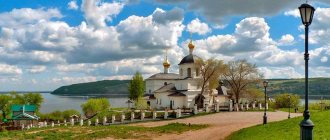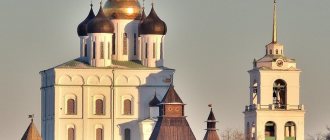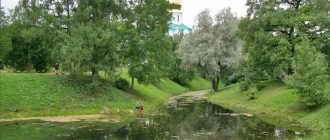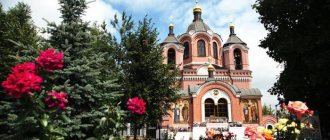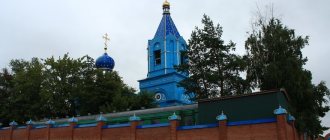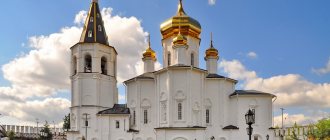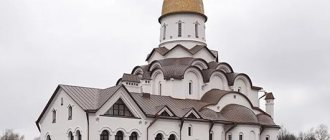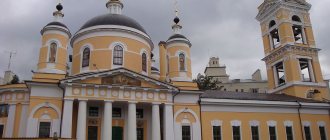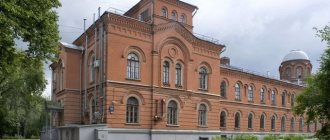The Church of the Holy Great Martyr George the Victorious is one of the inconspicuous sights of Moscow. It is bypassed by excursion tours around the capital. Not even all the indigenous residents of the city know where the Georgian church is located in Moscow. Nevertheless, it exists. And this is not just a temple, of which there are many in Moscow. This is a real little corner of Georgia.
In addition, the church has a very interesting history. And its interiors, as well as its exterior, are worth visiting this temple. And if you are a believer, then you will be interested to know that the church has the status of a patriarchal metochion, which is connected by Christian ties with the Seraphim-Znamensky monastery, the Cathedral of the Kazan Icon of Our Lady in the village of Puchkovo and the chapel of the Virgin Mary of Iveron.
Georgian Church in Moscow: address, how to get there
This temple is located in the central part of the Russian capital, on Presnya. The exact address of the church is Bolshaya Gruzinskaya Street, building 13. As we can see, the spirit of Iberia is present in the names of the places. There are also Malaya Gruzinskaya and Gruzinsky Val streets. As well as the lane and square of the same name. Why is there such an abundance of Georgian streets? We will talk about this below. For now, let’s be clear: many people think that there is a Georgian church in Moscow on Malaya Gruzinskaya Street. But that's not true. Just on Malaya Gruzinskaya there is a spectacular-looking Roman Catholic Church of the Immaculate Conception of the Virgin Mary. It is built in the neo-Gothic style and seems to be a corner of Western Europe in the center of the Russian capital, misleading some citizens.
Now let's return to the Georgian Church of St. George the Victorious. It is extremely easy to get to. You can get out of the metro at the Barrikadnaya station and from there walk or take trolleybus No. 66. An even simpler option for getting to the temple is from the station. metro station "Krasnopresnenskaya". Walk for about ten minutes, constantly moving along the fence of the zoo.
To help pilgrims
Divine services in the temple on Sundays and holidays begin at 9 am. At 8 o'clock anyone can confess. On Wednesdays at 18.00 a solemn prayer service is served with an akathist to the Georgian Icon of the Mother of God, on Fridays at 18.00 there is a remembrance of the departed.
Getting to the shrine is not difficult: on Kitaygorodsky Proezd you can take trolleybus number 2, 12, 23 and bus number 12c. The easiest way to get there is by metro from the Kitay-Gorod station to Varvarka Street. From the metro to the church it is literally a few minutes walk.
You can book a paid tour of the temple by checking the schedule of services.
Author's advice
The Church of the Life-Giving Trinity in Nikitniki is a unique opportunity not only to visit a place with magnificent architecture and decoration, but also to plunge into the unique atmosphere of Russian Orthodoxy.
If you find an error, please select a piece of text and press Ctrl+Enter.
Historical facts
Now it's time to figure out the reason for such frequent Georgian street names in this area. To do this, we need to take a short historical excursion. In the first quarter of the eighteenth century, Georgia was attacked by Türkiye. The Tsar, Vakhtang Levanovich the Sixth, came to Moscow in 1725 to ask for intercession from the Emperor of Russia Peter II. The Georgian monarch did not arrive alone. He was accompanied not only by his sons Bakar and George, but also by a large retinue. In 1729, Peter II granted Vakhtang Levanovich the sovereign's courtyard, which was located on the Presnya River. Then, on the site of the palace of the Georgian king, the merchant V. Gorbunov built a house. In the 70s of the twentieth century, the German Embassy was located in this mansion. Now the house houses the workshop of Zurab Tsereteli.
Well, the retinue of the Georgian king settled not far from their sovereign. Thus, over the course of several years, a fairly large diaspora has formed in Moscow. So big that this entire area on Presnya began to be called simply “Georgians”. That is why the monument to Shota Rustaveli was erected here, in St. George’s Park. But the Georgian church in Moscow appeared, of course, much earlier than the monument to the poet of the twelfth century.
Home » Liturgical life » Interior decoration
Interior decoration The decoration of the Church of the Life-Giving Trinity in Khokhly shows amazing harmony both in general and in detail. There is nothing superfluous here, nothing that could interfere with prayer. Everything that we see in the temple was recreated after 1991, because its original decoration was only partially preserved (the old iconostasis now belongs to the State Historical Museum and is in its storerooms).
The central Trinity iconostasis, consecrated in 2005, is bright, solemn, and festive. At the same time, its general ceremonial character is combined with the restraint of the faces, executed in an aristocratic, strict manner, but with great internal freedom. A special decorative effect is created by the ornamental halos of the central figures, and by the general design of the ornamental chapels (load-bearing horizontal beams), made using gold and silver, in warm muted red and cool blue and green colors. In contrast to the central one, the more modest iconostasis of the chapel of the Vladimir Icon of the Mother of God and the general design of the interior of the main volume of the temple look. The noble combination of white walls with dark brown wood icon cases, decorated with gold and silver ornamental inserts, creates an almost monastic atmosphere of simplicity and severity, warmth and silence, comfort and ease necessary for prayer.
Moving from the first general impression to a more detailed examination, in literally every icon you discover differences in the author’s writing. This is valuable - before us is a real living ensemble, where there is no averageness, mediocrity, but the voice of each participant complements the others, sounds, of course, within the framework of the Canon, but at the same time bright, independent, free and open, which indicates an atmosphere of trust in which work was underway to create the interior.
The rector of the temple, Archpriest Alexy Uminsky, managed to attract almost all the leading modern Moscow icon painters to work. And the choice fell on them, which is important, not only on the basis of their fame, but also because the customer subtly understood the peculiarities of the talent of these masters.
The leading role was given to the workshop of Alexander Lavdansky, in which icon painting was carried out by Lavdansky himself, and Alexey Vronsky, Andrey Bubnov, Anatoly Eiteneyer, Alexey Lukashin. Individual icons were painted by Sergei Fomin and Olga Tishchenko, Anton Yarzhombek, Alexey Litovkin, Margarita Proskurova, Antonina Markoch. Almost everything related to carving, both gilded and tinted, was done by Andrei Fekhner, a famous Moscow carver. The base fields and inserts were made by Nikolai and Maxim Lavdansky. The exceptions are two icon cases - the central one with the revered icon of the Mother of God “Seeking the Lost” and the pair next to it, standing on the other side of the arch, with the lining icon of St. Demetrius of Rostov. They, like the two jewelry crosses in the altar, which will be discussed below, were made by Vyacheslav Kopyl. The decorative design of the iconostasis of the chapel of the Vladimir Icon was created by Igor Builin.
Let's take a closer look at the most notable icons and talk about their authors. Let's start with Anatoly Eiteneyer - one of the most complex, bright, unusual and talented masters of modern Moscow. In his work, one can trace the obvious dynamics from an orientation towards the classics of ancient Russian art of the 14th–16th centuries, which can be seen in the icons of the Mother of God of Vladimir and the Intercession, located in the local row of the iconostasis of the Vladimir chapel, to the more “author’s” white background icons of the passion cycle, located in the central part temple. The latter are distinguished by their particularly elongated proportions, didactic silhouettes, and the finest combinations of color shades. Thanks to their scale and proximity to the beholder, it is possible to appreciate the rhythmic alternation of smooth lines, unexpected color combinations, and original geometric structures. Perhaps the most striking work is “The Descent from the Cross.” The proportions of the figures seem endless, there is no reference to anatomical accuracy. And what amazing colors! The most delicate pink, so successfully chosen to depict the mountains, does not look pretentious, but, on the contrary, exquisitely echoes the purple robes of Joseph of Arimathea, who carefully removed the body of the Savior from the Cross. According to the artist, the white background color in this case is one of the symbols of Paradise. Thus, this Passion cycle, in which the central icon of the Crucifixion may still appear, is painted white, symbolizing the nearness of the Resurrection, the victory of eternal life over death.
No less interesting is the “Old Testament Trinity” icon, painted by the same author to whom the artistic director of the project, Alexander Lavdansky, entrusted the painting of the main icon in the temple. The sample itself is remarkable - a Pskov icon of the second half of the 16th century, kept in the Treasury of the State Tretyakov Gallery, but the execution is no less successful. The centerpiece of the icon is extensively narrative and symbolically expressive. The Old Testament refers to the image of the appearance of the Trinity in the form of three Angels to Abraham and his wife Sarah. The slaughter of the calf by Abraham is also depicted here. How exquisite are both the color and composition solutions! How easily the complex task of fitting a multi-figure composition into a small centerpiece was solved. Nothing cluttered or cramped. And the slides, and the tree, and the architectural elements have whimsical silhouettes that defy any laws of “direct” perspective. The artist perfectly managed to reproduce the most complex cutting with a golden assist, symbolizing the uncreated light. Eight marks depicting scenes from the Book of Genesis give the icon theological depth. And again, the amazing subtlety in the solutions, both compositional and coloristic, is striking. Designed in rich tones, the color scheme goes well with the golden background and is readable even from a distance. The solution to writing the text from the Book of Genesis in white over gold is a good one - depending on the lighting, it either works in contrast or glows along with the gold.
It is impossible not to tell about the author of these works. Anatoly Eiteneyer was born in 1949 in the working-class village of Gornyak, Ryazan region, where his father, an exiled Russified German, worked in a mine. At the age of sixteen, the young man went to Tomsk, worked at a factory, and in 1969 he entered art school the first time. In 1975 he came to Moscow and participated in avant-garde exhibitions. His works were actively bought both in the USSR and abroad. Decisive for the choice of path was the artist’s acquaintance in 1984 with Archimandrite Zinon (Theodore), who came to Moscow to work on the paintings of the St. Daniel Monastery. It was then that Eiteneyer met Alexander Lavdansky, Alexander Sokolov, Andrei Davydov, Alexander Chashkin, now leading Moscow icon painters, with whom he later worked a lot. Of the most significant, it is worth mentioning his work in the Trinity Church in Nikitniki (festive row), icons in the Prince Vladimir Church in Starye Sady, icons in the Church of St. John the Theologian, festive row for the Church of the Savior Not Made by Hands in the village of Usovo, the last, not yet completed painting of the narthex Temple of Theodore the Studite at the Nikitsky Gate.
Let us continue our consideration of the central iconostasis. The central image of the Savior Pantocrator was made by Alexander Lavdansky. The master's artistic style is easily recognizable. Several variations can be discerned in the image, but the artist’s characteristic style stands out clearly and independently. We can talk about the author’s established style, which has absorbed both ancient Russian and Byzantine classics, and even took a little from the “natural likeness” of the 18th century. Before us is the image of the Savior, surprisingly restrained, with a clear, slightly stern, but merciful look, and a fatherly blessing gesture. The image of the God-man who accepted death for the human race. Calm coloring, muted colors of draperies, finely cut with a golden assist, precise proportions, everything reveals deep thoughtfulness and balance.
Alexander Lavdansky, founder of the Cinnabar workshop and director of work at the Church of the Life-Giving Trinity, was born in 1952. In the 1970s, the young avant-garde artist visited the workshop of Vasily Sitnikov, famous in those years, participated in exhibitions of alternative art, actively searched for new forms in painting and was quite successful in this. But one day, in the late 1970s, he received an order for church paintings from Bishop Ilya of Sukhumi (the future Patriarch of Georgia), and from that moment his entire future artistic path was determined. It is difficult to list the temples that house the master’s works today. In addition to numerous icons and frescoes in Moscow churches (Church of the Holy Fathers of the Seven
Ecumenical Councils in the St. Daniel Monastery, the Church of All Saints in Kulishki, the Church of the Three Hierarchs in Kulishki, the Church of the Hieromartyr Antipas in Kolymazhny Yard), he worked in the USA, Greece, and Ukraine. Alexander Lavdansky has participated in all major exhibitions of contemporary church art, starting with the first, held in 1989.
The formation of Lavdansky as a master was greatly influenced by the fact that from the very beginning he worked not so much individually as in a team with other icon painters, and mainly in the technique of monumental painting. The classic fresco technique—painting on wet plaster—requires fast and coordinated work. The blow of the hand should be fast, accurate and expressive. The temple is a huge organism, where everyone’s individual style must match the unified style of painting. Working in an artel teaches a lot, it is like singing in a choir, where each voice should not so much be a soloist, but, in harmony with other voices, build a single melody pattern. Having convinced himself of this from his own experience, the artist understands that only in an artel can one become an icon painter. When working individually, there is a great danger of developing authorial pride and vanity. All this is reflected in the works, as in a mirror. A sense of the collective, prayerful self-control and comments from “senior comrades” are necessary conditions for the improvement of a young artist.
Let us now consider the central image of the Trinity iconostasis - the Iveron Icon of the Mother of God, painted by Alexei Vronsky. Like all works by this author, the icon is made professionally and elegantly. Remaining monumental, the image withstands any approach. The clothes use complex, deep colors. The personal letter is multi-layered, translucent, and elaborate. The golden robes of the Infant Jesus carry the feeling of jewelry work. The mood of the image is restrained and peaceful; it reveals the providence and humility of the Mother of God before the future suffering and death of her Son.
Alexey Vronsky was born in 1964, in the family of the famous cinematographer Sergei Arkadyevich Vronsky, a close friend of the restorer and icon painter Savely Vasilyevich Yamshchikov. The latter, in turn, advised the young man, who graduated from the art school on Krasnaya Presnya, to enter the Kholuy School of Lacquer Miniatures, which was famous before the revolution for its icon painting school. In the early 1980s, after graduating from art school, Alexey immediately began to engage in icon painting: in 1986–1987 he collaborated with the Andrei Rublev Museum, took part in organizing the Isograph group of artists, and worked on the selection committee of the icon painting department at the International Federation of UNESCO Artists.
Already in the 80s, having started working in a team with Alexander Lavdansky and Alexander Sokolov, Alexey Vronsky moved away from the techniques of miniature painting and learned to work in monumental and easel manners. Today he is a great independent master,
having extensive experience in artistic work and teaching. Since 2006, he has been a consultant at the department of icon painting at the Orthodox St. Tikhon's Theological University. Subtlety and grace of writing, the ability to use nuances, and the inner nobility of images are the features of his artistic style. He is able to completely redo a huge work, as happened when decorating the altar of the Church of the Intercession of the Mother of God in the Holy Dormition Svyatogorsk Lavra in Ukraine, when he saw that the ornamental “towels” turned out to be too active, arguing with the subject compositions.
Another interesting work by Alexei Vronsky in the temple is the icon of St. Nicholas on the southern wall. The “countershade” technique is used here - against a light background, a darker image looks silhouetted, emphasizing the decorative pattern of a floral ornament with gold on gold on the halo. Against a generally dark background, the thinnest spaces give a special piercing image. But in general, we note classic restraint and prayerful contemplation.
Let's move on to the next remarkable icon - the image of St. Sergius of Radonezh in the local row of the iconostasis, made by a young but extremely interesting artist - Alexei Lukashin. The character of the icon differs sharply from the works of other masters. Extremely elongated proportions, angularity of folds, refinement of gestures, either a Gothic or Celtic pattern of an ornament on a red halo. The face also shows elongation and refinement of features. The hair and beard are painted very easily and quickly. The “Gothic” style of the entire image is supported by its characteristic bizarre grass, as if taken from medieval Western European manuscripts. However, for all its unusualness, this style does not seem to contradict the general spirit of the Orthodox icon; perhaps, on the contrary, it enriches it. The color scheme is based on a harmonious combination of primary colors: dark and light green and dark burgundy and light pink warm shade.
Alexey Lukashin was born in 1976. First, he graduated from the woodcarving department at the Abramtsevo Art School, and then from the Icon Painting School at the Moscow Theological Academy, one of the best icon painting schools in Russia. Lukashin is a member of the UNESCO Union of Artists, actively works both in the workshop of Alexander Lavdansky and in other artistic teams, paints icons, participates in monumental paintings, and also creates interesting sculptural works. He has already developed an individual and expressive author's style, which is manifested in works performed with a focus on different historical periods. He is distinguished by his rare ability to create a holistic image using small artistic means, internal freedom and the ability to embody his many ideas with apparent ease.
Andrey Bubnov-Petrosyan painted perhaps the largest number of icons in our church. We see the works of this master in all, except the local, rows of the Trinity iconostasis and on the northern wall of the main volume, where he painted almost all the images of the three-part icon cases. Let us highlight the most interesting, in our opinion, works. First of all, it is worth talking about the image of the holy righteous John of Kronstadt, located in the northwestern corner of the temple. The icon painter managed to create a recognizable, to a certain extent photographic, but at the same time very bright iconographic type. It is very difficult to work on images of saints of recent times, whose photographic images are well known. It is not easy to translate a photograph into the language of an icon. It often turns out that a new image is weaker than a photographic portrait. But here the master, who tended to focus on Byzantine and Russian pre-Mongol art, as well as being familiar with Western European Romanesque painting, managed to create a clear, moderately austere, bright image of everyone’s beloved saint. This severity and even some harshness, characteristic of the images of Andrei Bubnov, comes from a fairly ancient tradition, dating back to the 10th century - to depict saints with restraint, asceticism, monastic clarity, strictness, focused on prayer, grieving over the sins of the world, ready for spiritual feats . The author often uses contrasting color combinations, but in this icon everything is kept in a light color scheme, enriched with subtle ornamental inserts.
No less remarkable are two images from the Pyadnik row of the Trinity iconostasis - St. Spyridon of Trimifuntsky and St. Alla. One feels that they were executed “in one breath,” restrained but inspired. White clothes of St. Spiridona falls in heavy folds. Both in the face and in the beard, combinations of contrasting colors and rhythmic flowing lines give the image a special piercingness, drama, dynamics, and create a feeling of tension in spiritual life. Image of St. Alla, on the contrary, is more decorative, static, laconic, but surprisingly attractive thanks to the open, beautiful red color of the drapery covering the entire figure, which, in combination with a thin strip of dark green plate and gold halo and ornament, creates a strong decorative effect.
Another interesting icon of Bubnov, unfortunately hidden from the eyes of most of those entering the temple, is the image of the Entry into the Temple of the Blessed Virgin Mary,
located in the central altar. Remarkable for the grace of writing, balanced proportions and precision of colors, this chamber work deserves attention. It is made on a light pinkish background, with which the green color of the grass goes perfectly. The clothes of the central figures - the righteous saints Joachim and Anna, the Virgin Mary and the high priest - are also made using the contrast of open, saturated colors. In the entire scene, which has a sublimely narrative character, one can feel the thoughtfulness of the constructions, freedom and independence within the framework of traditional iconography.
The analysis of Andrei Bubnov’s works can be continued - there are enough wonderful images of this master in the temple. Particularly noticeable are the icon of the Archangel Michael from the Deesis rank with the amazing blue color of the cloak and two images located in icon cases on the pillars in the passage to the quadrangle - the Venerable Seraphim of Vyritsky and the Great Martyr and Healer Panteleimon. Looking at these amazing works, one is reminded of the third quarter of the 12th century - the golden age of Byzantine illuminated manuscripts with their refined shades of color. Andrey Bubnov uses similar colors in his works - deep, bright, but at the same time subtle and refined. The icon of St. George the Victorious on the northern wall of the temple and the female images on that tin are remarkable. In all these works there is a noticeable bright authorial element, which significantly enhances and enlivens the strict canonical painting.
Andrey Bubnov-Petrosyan was born in 1962 in Moscow. In 1982 he graduated from the restoration department of the Stroganov Art School. The artist’s ecclesiastical path began in 1983–1984, when Andrei participated in restoration work in the Moscow St. Danilov Monastery. Then, having received a church blessing, he began to study icon painting. In 1985–1988, the artist took part in painting the Church of the Transfiguration of the Lord near the city of Kashira. Recently, Andrey Bubnov has been working both independently and in collaboration with Alexander Lavdansky and Alexey Vronsky. The result of this cooperation were icons for the iconostasis of the Church of St. John the Evangelist in Moscow, the Church of St. Demetrius of Thessalonica, the Church of St. John the Evangelist in Yamburg, the Church of the Savior Not Made by Hands in the village of Usovo near Moscow and other churches. From 1998 to 2002, Andrei painted icons of three iconostases of the Church of St. Sergius of Radonezh in the village of Almazovo near Moscow. Since 2000, Bubnov has been painting a number of icons for the monastery of St. George Mavrovouni in Cyprus. Andrey Bubnov has participated in many exhibitions of modern icons, starting with the first.
The author’s style was strongly influenced by the work of Archimandrite Zinon (Theodore), who, from focusing on ancient Russian examples, went “back into the depths of time” and reached Byzantine art of the 10th–11th centuries. In many of his images, a love for Byzantine miniatures of illustrated manuscripts clearly appears. Bold work and a subtle sense of color are another characteristic feature of the works of Andrei Bubnov, one of the best modern icon painters.
The next, no less interesting author, Anton Yarzhombek, also did a lot for the temple. The facade of the temple is decorated with a fresco with the composition “Abraham’s Hospitality”, painted by this famous Moscow artist. The interior contains about a dozen icons of his writing: a red background image of St. Spyridon of Trimifunt on the southern wall, a lectern image of the not so long ago glorified St. John of San Francisco, an image of St. Sergius of Radonezh, a number of icons in the iconostasis, as well as a large icon of the holy Royal Passion-Bearers and those who suffered with them , located in front of the iconostasis on the right, the author of the iconography of which is Archpriest Alexei.
Let us dwell in more detail on the image of St. Spyridon. The iconography is recognizable, but at the same time the master’s author’s approach is visible. The form is built with bold, strong, expressive strokes. The movements of the brush are confident and very lively. This is the hallmark of an artist. Despite all the conventionality of the icon’s language, the viewer has a feeling of living communication with the image. Anton Yarzhombek is an amazing master who has such a rare quality as inner looseness. Hence the clarity and lightness in his works.
Anton Yarzhombek was born in 1960 in Petropavlovsk-Kamchatsky. In 1976 he entered the TXTU in the make-up department. I began studying icon painting in 1982 on my own, consulting with fellow icon painters: Alexander Sokolov, Alexander Lavdansky, Alexei Vronsky, Anatoly Sedelnikov. In 1988, the master’s fruitful collaboration with icon painter Vladimir Lyubarsky began, which continues to this day. In 1989, they both participated in the first exhibition of modern icons. Among the artist's main works is the painting of the side chapels of the Church of St. Fathers of the Seven Ecumenical Councils in the St. Daniel Monastery, icons in the Church of All Saints on Kulishki, in the Church of John the Theologian, in the Church of St. Prince Vladimir in the Old Gardens, paintings of the St. Nicholas Cathedral of the Holy Trinity Convent in Tashkent, the altar barrier of the left side chapel of the Church of Cosmas and Damian in Shubin, the Church of John the Baptist in the village of Gorki-8, Moscow Region, as well as the Church of St. Sergius of Radonezh in the village of Almazovo, Moscow Region .
Another icon painter who worked for the temple was Margarita Proskurova. Having started working here even before the building was transferred to the Church, she painted the Royal Doors for the chapel of the Vladimir Icon of the Mother of God, the canopy, columns, the deacon's door with the canopy and the Image of the Savior Not Made by Hands. It is interesting that forged hanging hinges were used in the design of the Royal Doors, “giquelines”, which make it possible to place images on two surfaces of the columns - front and interior, which gives architectural volume to the entire composition. For Margarita, this was the first independent work after graduating from the Icon Painting School of the Moscow Theological Academy, and this work must be considered successful.
She also made the icon of the Archangel Michael, located on the southern wall above the entrance to the sacristy, the icon of the healer Panteleimon, the three holy martyrs, and the composition “Communion of the Saints Zosima Mary of Egypt.” I would like to especially note two of her works, commissioned by the famous scientist Alexander Dvorkin, who performs the obedience of a reader in the church - the icons of St. Herman of Alaska and the Hieromartyr Irenaeus of Lyon, located on the western wall. Soft features, elongated proportions, interesting attributes of saints, in-depth, attentive glances directed towards the future are characteristic features of the artist’s manner.
Before us are the works of a mature, independent author with an individual approach and a special vision. They are characterized by special gentleness, sensitivity, and humanity in a high sense. These features go back to the founder of the Icon Painting School at the MDA - nun Juliania Sokolova. One can also recall the manner of Grigory Krug and Leonid Uspensky, the special “closeness” of their images. I think it is very important to represent a saint, exalted, transformed, but also a real person on an icon, as if emphasizing: anyone can become like that.
An interesting story told by Margarita: “The following incident is connected with my work for the Trinity Church in Khokhly. Somewhere in the mid-90s, Elena Cherkasova (now a famous artist and graphic artist working in religious themes. - Author), after more than a ten-year break, took up a brush. At that time, she only had watercolors, which did not fully suit her artistic temperament. The question arose about buying canvases and oil paints, but there were no funds. She decided to sell a set of liturgical Menaion. “Don’t know who would?” - she asked me. “Me, me!” I shouted; I really needed it, since I was then fulfilling the duties of a charter director in the Ivanovo Monastery, which was being restored by our community. But I didn’t have the funds either. Here about. Alexey Uminsky commissions me for the image of the Recovery of the Dead. This is how everything worked out: I received the Menaion, Lena Cherkasova canvases and paints, the Church of St. Trinity in Khokhly - an icon (now revered as miraculous - Author), and the world - a wonderful artist.”
Margarita Proskurova was born in Moscow. In 1988 she graduated from the Printing Institute. In the early 90s she studied at the Icon Painting School at the MDA - the first graduating class. She worked at the Church of Prince Vladimir in the Old Gardens, in the monastery of St. John the Baptist, in the Church of St. Sergius of Radonezh in Businovo, the Church of the Martyr Tatiana at Moscow State University, for the metochion of the Conception Monastery in Barvikha, the Church of the New Martyrs and Confessors of Russia in Kommunarka and others. She also carried out private orders in Russia, Italy, Scotland and Germany.
There is another revered icon in the temple - the Cathedral of the Elders of Optina, made by Sergei Fomin. The author of its iconography is Father Alexei Uminsky. One icon combines the image of the fourteen Elders of Optina and the Most Holy Theotokos from the “Different of the Loaves” icon. When painting the faces, photographs of the elders were used. At the request of Fr. Alexei from the Optina Pustyn monastery, particles of the relics of all the saints were transferred to this icon and placed on its margins.
Another large-scale work by the same master is the icon of the Forty Martyrs of Sebaste, located opposite the central iconostasis, on the southern pillar. The master was guided by ancient half-length fresco images of martyrs by Greek artists. The enormous painstaking work done by the author is visible. Faces, figures, clothes are carefully described.
Among other icons of Sergei Fomin in the temple, one cannot fail to note the image of St. Alexei the Man of God, patron saint of the rector of the temple. As is known from the life of this saint, he preferred life in obscurity and desecration for the sake of spiritual improvement to a rich inheritance. The author managed to convey this spiritual impulse.
Sergey Fomin was born in 1960. In 1978 he graduated from the Faculty of Architecture of the Moscow Institute of Land Management Engineers. He took his first lessons in icon painting from Alexander Lavdansky. In 1987, he began working as an architect-restorer at the Danilov Monastery, where he met Archimandrite Zinon. The formation of the artist’s style was influenced by the work of another famous icon painter, Pavel Busalaev. From 1997 to this day, he has been actively working in collaboration with many Moscow icon painters, fulfilling orders from churches, monasteries, and private individuals.
We have already noted that the rector managed to collect in one church the works of almost all the leading modern icon painters, and in this regard, we note one more name, represented here by only one icon of the holy righteous John of Kronstadt, located in the altar. We will talk about the priest-icon painter Andrei Davydov. The icon was painted in 2008 using the encaustic technique - painting with mineral paints with a wax binder. Father Andrei Davydov is one of the few artists working with wax paints today. In addition to the rare technique, the style of execution of the icon is also unusual. Contrasting colors, exaggerated proportions, large features, energy and expression - all these are distinctive features of the artist’s creative style. The master focuses on early Byzantine and even Romanesque art.
Andrey Davydov was born in 1957 in Moscow. He began to study icon painting in 1978, immediately after graduating from the staging department of the Moscow Art Theater School with a degree in stage artist. Before his ordination in 1988, he worked in the workshops of the Moscow Patriarchate, St. Daniel's Monastery. He graduated from the St. Petersburg Theological Seminary and is currently continuing his studies at the Academy. The priest-icon painter lived in Pskov for twelve years, where he managed to do a lot. In addition to painting churches and painting icons for clients around the world, Father Andrei teaches the basics of icon painting in Italy, writes theoretical works on the theology of icons, and participates in exhibitions of contemporary church art. Now Priest Andrei is restoring the Nativity and St. Nicholas churches in Suzdal, of which he is the rector.
We have already mentioned two jewelry crosses located in the central altar. These works of decorative and applied art were created by the famous Moscow jeweler Vyacheslav Kopyl.
The master was born in 1962 in Moscow, began to study jewelry art in 1986 under the guidance of Archimandrite Zinon and the recently deceased remarkable professional Mark Lozinsky.
Let's take a look at his work. Along the entire surface of the large external cross against the background of the basma ornament there are small icons made using the silver casting technique with gilding and hot enamel inserts. On the small cross the pattern of the ornament is larger. Gilded relief inserts are also cast. Both crosses are generously decorated with ornamental stones and pearls of various sizes. Vyacheslav also owns most of the basma works in the temple. The master managed to fully realize the capabilities of this ancient technique, creating laconic, expressive, memorable works.
Among other examples of decorative and applied art decorating the interior of the temple, one cannot fail to mention the “towels” (decorative panels) of the iconostasis. Made using the technique of gold embroidery, they depict the Instruments of the Passion. This wonderful, completely handmade work was created by parishioner Nadezhda Sakharova. It should be noted that hand sewing, which has a completely different “creative energy” than machine embroidery, which is ubiquitous today, brings irreplaceable notes of warmth and belonging to the interior of the temple.
Among the masters we must also name Antonina Markoch, who created the design of the iconostasis of the Vladimir chapel, its upper Deesis and short prophetic rows, as well as the beautiful Crucifixion.
The Father Superior also attracts young talented icon painters to work on the temple. One of them is Alexey Litovkin, who graduated from PSTGU in 2004. For the temple, he painted an icon of three saints - Basil the Great, John Chrysostom and Gregory the Theologian, based on a famous 16th-century icon kept in the Tretyakov Gallery. Now this work is located in the central part of an unusual temple bench, which combines places for parishioners and icons of saints above them in a single structure. Despite all its atypicality, this piece of furniture is unusually organic for an Orthodox church, in which during the service the deacon equally burns incense to both the praying people and the saints on the icons, who are spiritually present with the gathering of believers. I would like to note this solution as natural for the temple space we are considering. Indeed, here every object, every design and image is, as it were, materialized evidence of the breath of living parish life, the fruits of the artistic self-expression of the community, which, along with the masters and icon painters, can be considered their spiritual co-author.
Let's summarize some results. Before us is a temple from the early 17th century, restored after complete destruction. The architecture has preserved the spirit of its time, and the newly created interior prolongs the centuries-old spiritual tradition in our days. In one small space, the works of almost all the best modern church masters are collected here, and the bright author's style of each of them brings its own unique notes to the wonderful overall ensemble.
This is a wonderful and, unfortunately, rare situation for modern church art. Today we too often see on the walls of churches slavish, dry copies of beautiful icon paintings, but taken out of context. Meanwhile, the church craftsmen of the heyday worked completely differently. In classical Russian and Byzantine icon painting there was no literal copying, and not only because there were no photographic equipment, projectors and digital databases. The artists of antiquity were not “universal professionals” capable of reproducing any image, but, above all, the eyes and hands of a community of believers who beautified their temple space. Therefore, their works bore many nuances, special features characteristic of the place and time, the surrounding nature and environment, aesthetic preferences and the characteristics of the talent of both the master and the customer-community. That’s why their work looks so sincere and inspired.
The interior of the Church of the Life-Giving Trinity in Khokhly shows that even today such a miracle of collective creativity, a polyphonic symphony, where each voice is heard and unique, is possible.
Anna Chukina
- "Light of the Trinity"
History of the temple
The Iberian diaspora needed a place to worship. The money for the construction of the temple was allocated by Vakhtang’s son, Tsarevich George. The place in the settlement for the sacred building was not chosen by chance. After all, there had previously stood an Orthodox church dedicated to the Evangelist John. But this temple burned down. And in its place the Georgian community built a new wooden church. Already in April 1750, the temple was consecrated by the Georgian archbishop who lived in Russia, Joseph. This church stood for almost thirty years. But wooden structures too often fall victim to fire. This fate did not spare the “Temple on Georgians” either. The community decided to rebuild it in stone.
The new Georgian church in Moscow began to be built in the autumn of 1788, nine years after the fire. After all, it was necessary to write a petition to Metropolitan Platon (Levshin) of the Russian Orthodox Church to obtain permission to build a temple. In 1870, a bell tower was erected.
History of construction
Pyatino was once a Cossack village, but from the end of the 17th century. in the middle of the 19th century it was owned by the wealthy noble family of the Annenkovs . Among its representatives since the 15th century. - governors, royal officers, high-ranking officers. And there is also a participant in the famous uprising of December 14, 1825 - Ivan Annenkov, who has the most direct relation to Pyatino: it was the estate of his mother, Anna Ivanovna. She began building the church in 1823, as a memory of her late husband - a brilliant officer, then a civil official (he had the rank of state councilor).
However, it soon turned out that the church was created as a sacrifice to God about a son who had “lost his way,” a participant in the uprising against the king. However, secular gossips had little faith in Anna Ivanovna’s sincerity: everyone knew that after the uprising she, the owner of very extensive, rich estates, refused money to her son’s wife, Polina Gebel, who intended to free her husband from the Peter and Paul Fortress and go abroad with him.
So Polina, leaving the world, followed Ivan into Siberian exile. And Ivan Alexandrovich and his wife were able to return to their homeland only in the 1850s, when the Decembrists, who had served their sentences for more than 25 years, received freedom with the beginning of the reign of Alexander II. By this time, the Decembrist’s mother had already died - now the temple also became a memory of her.
Interesting fact
There is evidence that during these years, the Frenchman Alexandre Dumas visited Annenkov - now a public figure, a participant in the preparations for the abolition of serfdom. Most likely, he was also under the arches of the beautiful Trinity.
True, the immediate reason for the visit was, apparently, the desire to personally get acquainted with the prototype of the hero of the novel “The Fencing Teacher,” where the Decembrist was depicted under the name “Count Alexis Vaninkov.” The basis of the novel was the stories of the Frenchman, who actually taught Annenkov the skill of fencing. However, the picture of the Decembrist’s real life is greatly “corrected”; he is presented as a repentant “state criminal”, forced to participate in the riot, but not sharing the ideas of the organizers.
Recent history of the church
At the end of the 19th century (1895-1899), the Georgian church in Moscow was completely rebuilt. Architect V. Sretensky increased the size of the temple and gave it the appearance of a Byzantine basilica. This new building was organically adjacent to the old building on the east side. With the advent of Soviet power, difficult times came for the church. In 1922, everything more or less valuable was taken out of it. The bells were removed and the library was plundered.
In 1930, the temple was completely closed. The bell tower was dismantled, and the church building was divided by interfloor ceilings. All this was done in order to install an electromechanical technical school in the religious building. Only in 1933 the old part was returned to believers. An agreement was reached between the Russian and Georgian Orthodox Churches on the joint use of the temple. In 2015, the technical school was evicted from the new part of the building. But much of its former splendor has been lost.
Architecture
Trinity is one of the few rural churches where one can at least guess the name of the architect. Moreover, there are two versions here.
Photo by Natalia Velikanova, August 15, 2015
Both talk about high-level architects, as they say, “with a name”:
- according to the most widespread opinion, which, however, has the character of a local legend, the church project was created by an outstanding architect, a graduate of the Academy of Arts, Mikhail Petrovich Korinfsky , who worked a lot in Simbirsk; it is believed that Trinity should have stood on the main square of the city, but A.I. Annenkova allegedly bought it from the architect;
- the version of local history specialists looks somewhat different: the cathedral on Simbirsk Square was really planned - as a memory of the war of 1812, moreover, a competition was even held, where, however, the project of ... M.P. Korinfsky won; but the drawings of another famous architect, M.P. Rushko, whose project did not win, could, according to scientists, become the basis for the construction of the Pyatino Church - also Trinity.
In any case, the style of construction is clearly defined as classicism, the favorite style of both Korinfsky and Rushko. The five-domed temple is decorated with magnificent columns - this is a characteristic feature of the style, dating back to the ancient tradition - not only on the outside, but also on the inside, where the colonnade formed the basis for the altar barrier.
Inside the building, elements of stucco molding of the same classical style, which are characterized by severity of form, but at the same time solemnity, even elegance, have also been preserved.
The temple, in addition to the main one, had two chapels:
- St. Simeon the God-Receiver and the prophetess Anna;
- Vmch. Catherine.
It must be assumed that the dedications of the chapels were connected with the heavenly patrons of the Annenkov family. Well, the chapel of St. Catherine may be dedicated to the saint, the namesake of the next owner of the estate - Countess Ekaterina Ruzhevskaya , to whom the estate was sold by the Annenkovs.
Church of St. George in Moscow
The Georgian community has invested and continues to invest a lot of money to give the desecrated building its former appearance. Now a complete restoration of the old part of the temple is underway. Officially, the Church of St. George belongs to the Russian Orthodox Church, the Moscow Patriarchate. But according to the agreement, the priest of the Georgian Orthodox Church conducts services there. The church also has a refectory and a children's Sunday school. Georgians in Moscow respect their customs and want their children not to forget the traditions of their ancestors. That's why they teach language at school.
It is worth entering under these arches to admire the patterned lectern and the most revered icon of St. George the Victorious, located in a gilded icon case to the right of the altar. The beautiful interior paintings are amazing. The frescoes were made by the famous artist Lasha Kintsurashvili, who specially came from Georgia. They shimmer with bright colors.
Architecture of the Church of the Life-Giving Trinity in Nikitniki
The museumification of the temple became the key to preserving the external appearance and unique interior of the church. The uniqueness of the structure is felt from the moment you first look at it: the fact is that the church looks different from different sides. When viewed from the eastern side, it seems that the building is directed upward, while from the western side it blurs and breaks up into the constituent parts of the quadrangle. A certain spatial illusion is created by the lengthwise and height-elongated gallery, the bell tower and the tent-shaped porch.
The composition of the church was undoubtedly influenced by the architectural traditions of previous architecture. But there is also an author’s twist in solving the problem of external volume and internal decoration - according to the architect’s plan, the aisles are located asymmetrically. The external decoration is very elegant and immediately attracts attention. The southern wall facing the street is richly decorated with paired columns and a complex entablature with a multi-broken cornice. Decorative details include colored tiles and white stone carvings. The general character of the frame is dominated by ornamental motifs.
The multi-figure dynamic painting of the interior of the temple was made according to drawings of the Holy Scripture (by the brush of the artist Bocht from Holland), which were created by the best artists from the Armory Chamber. The painting of the temple served as an impetus for a new direction in Russian church architecture.
The icons for the iconostasis were painted by Joseph Vladimirov and Simon Ushakov. It is in the temple on Nikitniki that a unique work is kept - “The Tree of the Russian Sovereigns”.
Church services on Sundays and holidays begin at 9 a.m.
Trinity Church has been restored more than once
Church of the Life-Giving Trinity in Nikitniki
Restoration plans and their implementation
Only by 1990 did the building appear in the register of regional cultural monuments - now it could be restored with the participation of the state. But they didn’t expect any participation. Since 2015, an initiative group took over the matter, which soon became a parish.
A year later, over the resting place of St. Maxim, a temporary church of St. Seraphim of Sarov , albeit quite small, but services began here. But the first of them in many decades took place in the crumbling Trinity - but how could it be otherwise, after all, it was Pentecost , its patronal feast day.
Ulyanovsk region, Pyatino. Church of the Life-Giving Trinity. First liturgy June 20, 2016. Trinity
Photos dated June 20, 2016 show that the floor of the Orthodox church is covered, according to holiday tradition, with grass and flowers. Dilapidated walls, with crumbling plaster - but cleared of blasphemous inscriptions! –decorated with young greenery. And during the service . There is no doubt: Trinity lives again!
Saint at the parish
Parish life would have been unremarkable if not for the personality of one of the parishioners - Maxim Yakovlevich Mitryasov, now known as the locally revered saint, Maxim Pyatinsky (canonized in 2011).
Elder Maxim Pyatinsky (Inzensky).
The elder was born not far from Pyatino, in the village of Tiyapino, around the middle of the 19th century, and departed to the Lord already in the 1920s, during anti-church persecutions. Many old-timers recalled his lifetime spiritual gifts - healings, insight. And one day he sat down on a cart with a peasant and ordered him to go home, although it was clearly going to rain, and with a storm.
The villager said that he did not agree: “Father Maxim, let’s go back, cloud, priests, I’m afraid.” And he: “ Don’t be afraid, God is stronger than all .” It’s raining, but the horse is dry and the cart is dry...”
Many, however, considered Maxim a holy fool, crazy, and even mocked him - because he covered up his holiness with unusual behavior - he slept with his head on a log and put his feet on a pillow, often walked barefoot in winter, and wore chains on his body. Only later, after the death of the saint, many recalled his fulfilled prophecies, including the following:
“The whole village will soon be wrapped in a snare. As you live, you will remember... And people will beat each other!”
This was a prediction of persecution of faith.
